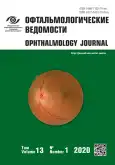Choroid melanoma, developed from nevus
- Authors: Stoyukhina A.S.1, Lerner M.Y.2
-
Affiliations:
- Research Institute of Eye Diseases
- S.P. Botkin City Clinical Hospital
- Issue: Vol 13, No 1 (2020)
- Pages: 91-94
- Section: Case reports
- URL: https://journals.rcsi.science/ov/article/view/21328
- DOI: https://doi.org/10.17816/OV21328
- ID: 21328
Cite item
Abstract
It is known that 25% of choroidal nevus are suspicious, and the risk of their malignanisation is 2-13% with a tendency to increase during follow-up me elongation. It is known that 5.8% undergoes malignancy within 5 years, and 13.9% of suspicious choroidal nevi undergoes malignancy within 10 years. In the article, a clinical case of choroidal melanoma development 5.5 years after the detection of suspicious nevus in a patient who refused to follow up is described. In the presented case, there was a combination of two risk factors of nevus malignisation, which significantly increases the likelihood of such an outcome. Long-term follow-up of patients is required from the first day of diagnosis “nevus of the choroid with signs of progression”.
Full Text
##article.viewOnOriginalSite##About the authors
Alevtina S. Stoyukhina
Research Institute of Eye Diseases
Author for correspondence.
Email: a.stoyukhina@yandex.ru
ORCID iD: 0000-0002-4517-0324
SPIN-code: 6084-8052
Scopus Author ID: 56928348200
ResearcherId: AAG-7030-2019
PhD, Senior Research Associate of Department of Retina and Optical Nerve Pathology
Russian Federation, MoscowMarina Yu. Lerner
S.P. Botkin City Clinical Hospital
Email: mlernerdoc@mail.ru
PhD, Head of ophthamooncology department
Russian Federation, MoscowReferences
- Kaiserman I, Kaiserman N, Pe’er J. Long term ultrasonic follow up of choroidal naevi and their transformation to melanomas. Br J Ophthalmol. 2006;90(8):994-998. https://doi.org/10.1136/bjo.2006.090738.
- Офтальмоонкология. Руководство для врачей / Под ред. А.Ф. Бровкиной. – М.: Медицина, 2002. – 420 с. [Ophthalmooncologiya. Rukovodstvo dlya vracey. Ed. by A.F. Brovkina. Moscow: Meditsina; 2002. 420 р. (In Russ.)]
- Singh AD, Kalyani P, Topham A. Estimating the risk of malignant transformation of a choroidal nevus. Ophthalmology. 2005;112(10): 1784-1789. https://doi.org/10.1016/j.ophtha.2005.06.011.
- Shields CL, Furuta M, Berman EL, et al. Choroidal nevus transformation into melanoma: analysis of 2514 consecutive cases. Arch Ophthalmol. 2009;127(8):981-987. https://doi.org/10.1001/archophthalmol.2009.151.
- Shields CL, Lim LA, Dalvin LA, Shields JA. Small choroidal melanoma: detection with multimodal imaging and management with plaque radiotherapy or AU-011 nanoparticle therapy. Curr Opin Ophthalmol. 2019;30(3):206-214. https://doi.org/10.1097/ICU.0000000000000560.
- Shields CL, Demirci H, Materin MA, et al. Clinical factors in the identification of small choroidal melanoma. Can J Ophthalmol. 2004;39(4):351-7. https://doi.org/10.1016/S0008-4182(04)80005-X.
- Li HK, Shields CL, Mashayekhi A, et al. Giant choroidal nevus clinical features and natural course in 322 cases. Ophthalmology. 2010;117(2):324-333. https://doi.org/10.1016/j.ophtha.2009.07.006.
- Shields CL, Cater J, Shields JA, et al. Combination of clinical factors predictive of growth of small choroidal melanocytic tumors. Arch Ophthalmol. 2000;118(3):360-364. https://doi.org/10.1001/archopht.118.3.360.
- Бровкина А.Ф., Стоюхина А.С., Мусаткина И.В. Оптическая когерентная томография в диагностике начальных меланом хориоидеи // Вестник офтальмологии. – 2016. – Т. 132. – № 5. – С. 23–34. [Brovkina AF, Stoyukhina AS, Musatkina IV. Diagnostic potential of optical coherence tomography for small choroidal melanomas. Annals of ophthalmology. 2016;132(5):23-34. (In Russ.)]. https://doi.org/10.17116/oftalma2016132523-34.
- Стоюхина А.С., Мусаткина И.В. Морфогенез меланом хориоидеи в свете оптической когерентной томографии // Вестник офтальмологии. – 2018. – Т. 134. – № 5–2. – С. 186–194. [Stoyukhina AS, Musatkina IV. Morphogenesis of choroidal melanomas in OCT imaging. Annals of ophthalmology. 2018;134(5-2):186-194. (In Russ.)]. https://doi.org/10.17116/oftalma2018134051186.
Supplementary files











